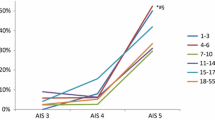Abstract
Head injury is the most common cause of death following trauma among children in most developed and underdeveloped countries. Management of the head-injured child remained conservative in the hands of the general and orthopedic surgeons until October 2000 in our center. To determine outcome and outcome-predictors in children managed nonoperatively for head injury in Ilorin, Nigeria, a 10-year retrospective study of children managed for head injury was done. Outcome was measured by Glasgow outcome scoring. Clinical variables including age, gender, and postresuscitation Glasgow coma score were tested against Glasgow outcome score by linear regression analysis. During the study period (1989–1999), 267 children (173 males and 94 females) aged 16 years and below with head injuries were admitted. Their injuries were due mostly to road traffic accidents (64.1%) and falls (30.7%). Other injuries were domestic, sport-related, or due to assaults or the fall of collapsed walls, water-pots, and coconut shells on victims’ heads. Head injuries were isolated in 60% of patients but associated with skeletal, facial, and spinal injuries in 58, 18, and seven cases, respectively. They were mild in 100 (37.5%), moderate in 73 (27.3%), but severe in 94 (35.2%) cases. Outcome was good in 207 (77.5%) but fatal in 38 (14.2%) children. Only age (p=0.0206) and coma score (p=0.0000), but not gender (p= 0.3043), could predict outcome. Outcome was good in more than 75% of cases of head-injured children managed nonoperatively. It varied with the patient’s age and postresuscitation Glasgow coma score.

Similar content being viewed by others
References
Bell WO (1995) Pediatric trauma. In: Arensman RM (ed) Pediatric trauma: initial care of the injured child. Raven Press, New York, pp 101–118
Olumide AA, Adeloye A (1982) Indications for surgery in head injury. Cent Afr J Med 28:272–275
Shokunbi MT, Solagberu BA (1995) Mortality in childhood head injury in Ibadan. Afr J Med Sci 24:159–163
Sharma AK, Sarin YK, Manocha S, et al. (1993) Pattern of childhood trauma. Indian perspective. Indian Pediatr 30:57–60
Hsiang JN, Goh KY, Zhu- XL, Poon WS (1996) Features of pediatric head injury in Hong Kong. Childs Nerv Syst 12:611–614
Chan BS, Walker PJ, Cass-DT (1989) Urban trauma: an analysis of 1,116 paediatric cases. J Trauma 29:1540–1547
Jennett B, Bond M (1975) Assessment of outcome after severe brain damage. A practical scale. Lancet 1:480–484
Brooke M, MacMillan R, Cully S, et al. (1990) Head injuries in accident and emergency departments. How different are children from adults? J Epidemiol Community Health 44:147-151
Teasdale G, Jennett B (1974) Assessment of coma and impaired consciousness. A practical scale. Lancet 2:81–84
Temkin NR, Dikmen SS, Winn HR (1991) Management of head injury: post traumatic seizures. Neurosurg Clin North Am 2:425–435
Luerssen TG (1991) Head injuries in children. Neurosurg Clin North Am 2:399–410
Author information
Authors and Affiliations
Corresponding author
Rights and permissions
About this article
Cite this article
Odebode, T.O., Abubakar, A.M. Childhood head injury: causes, outcome, and outcome predictors. Ped Surgery Int 20, 348–352 (2004). https://doi.org/10.1007/s00383-004-1196-5
Accepted:
Published:
Issue Date:
DOI: https://doi.org/10.1007/s00383-004-1196-5




